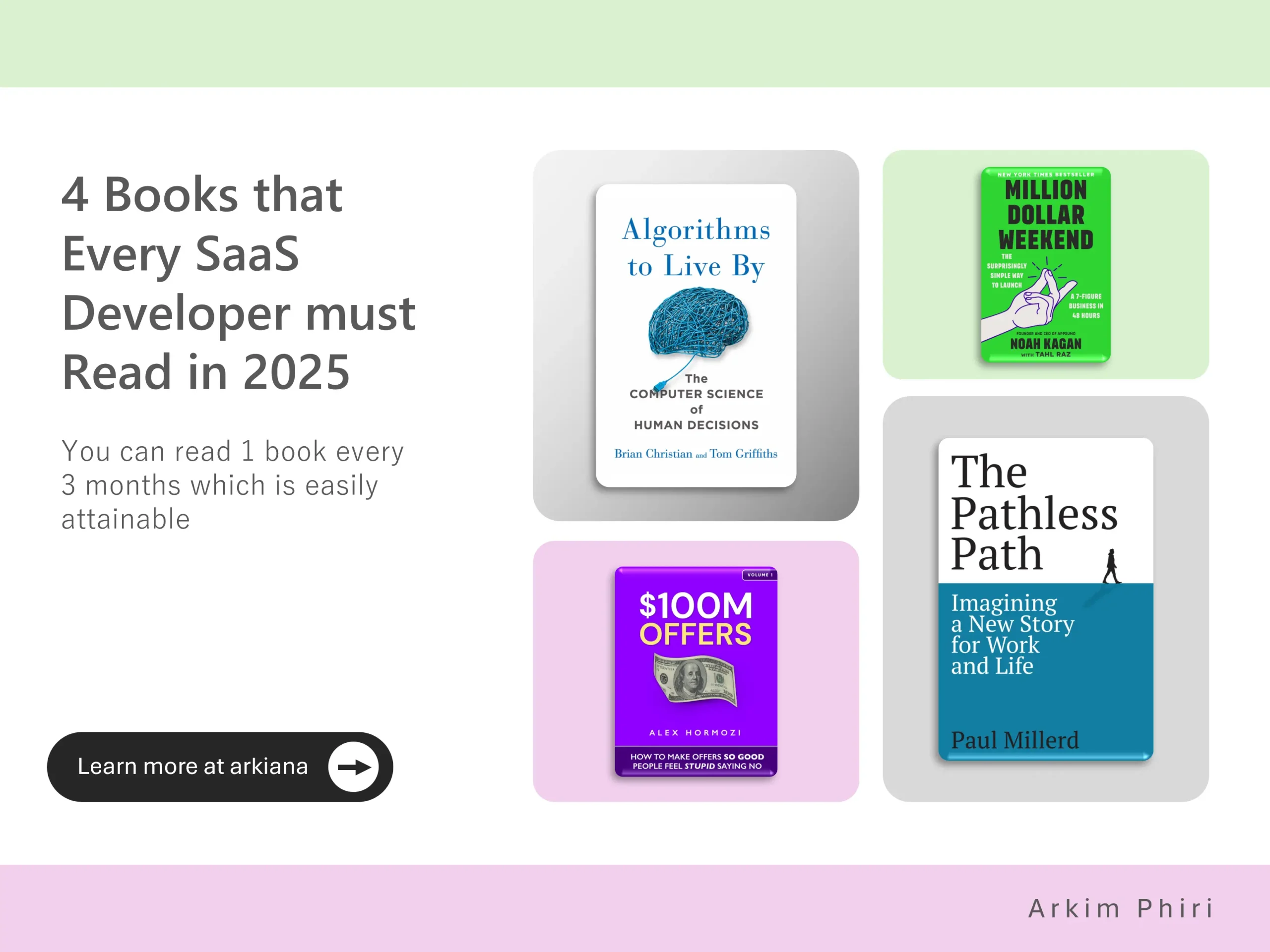Solopreneurship for Software Developers
Solopreneurship for Software Developers

These books will help you grow your SaaS business in way you have never imagined.
You can read 1 book every three months, making it easy to digest and act on the knowledge that you get.
Algorithms to live by, by Brian Christian and Tom Griffiths explores how algorithms from computer science can be applied to solve everyday problems and improve decision-making in life.
The book covers topics such as optimal stopping, scheduling, and dealing with uncertainty (such as balancing exploration and exploitation).
By drawing parallels between computational challenges and human dilemmas, the authors show how concepts like randomness, sorting, caching, and prioritization can lead to more effective strategies in both personal and professional contexts.
For SaaS developers, the principles in the book provide actionable insights.
For example, the concept of optimal stopping can guide decisions about hiring talent or releasing new features—knowing when “good enough” is actually the best decision.
The trade-off between exploration and exploitation helps developers balance innovating with new features versus refining existing ones to maximize customer satisfaction and retention.
Additionally, the chapters on scheduling and prioritization are invaluable for managing tasks in software development pipelines, ensuring deadlines are met without overburdening teams.
By applying these computational strategies, SaaS developers can streamline their processes, optimize resource allocation, and make better, data-informed decisions.
Million Dollar Weekend by Noah Kagan is a guide focused on how entrepreneurs can use urgency, focused action, and smart strategies to generate a significant amount of revenue over a short period—often within a single weekend.
The book outlines actionable steps, including the importance of validating ideas quickly, leveraging existing audiences, and simplifying product offerings.
Kagan emphasizes the power of setting aggressive deadlines to push creativity and productivity.
The key takeaway is that by cutting out distractions, focusing on high-impact activities, and engaging directly with potential customers, entrepreneurs can test and monetize their ideas with minimal resources.
For SaaS developers, the principles in the book are highly applicable.
SaaS products often require extensive time and resources to develop, but Million Dollar Weekend encourages starting with a Minmum Viable Product (MVP) to validate the idea.
By using tools like landing pages, surveys, or prototypes, developers can test demand and gather feedback before committing to full-scale development.
You may also like: Making $100,000/year with AI Assistants
Additionally, the book’s focus on leveraging urgency and direct customer engagement can help SaaS developers pre-sell subscriptions, create buzz, and build a loyal audience early in the process.
This approach minimizes risk and maximizes revenue potential in a highly competitive market.
$100M Offers provides a framework for crafting irresistible offers that make price a non-issue for customers.
Alex Hormozi emphasizes the importance of understanding your target audience’s desires, pain points, and perceived value.
The book introduces the concept of a “value stack,” which bundles additional benefits and solutions to enhance the perceived worth of an offer.
Hormozi advocates for identifying a “dream customer,” offering them a compelling promise, and delivering results that exceed expectations.
The key is to create offers so valuable that customers feel the deal is “too good to pass up,” all while maintaining profitability for the business.
The book also delves into pricing strategies, emphasizing the importance of charging what the value is truly worth rather than competing on price alone.
Hormozi introduces tools like the Value Equation, which includes factors such as perceived value, time delay to results, and effort required by the customer.
By reducing customer effort and increasing their perceived value, businesses can create irresistible offers that drive exponential growth.
For SaaS developers, $100M Offers provides a playbook to differentiate their software in a competitive market.
Developers can apply the principles by deeply understanding their niche audience’s pain points and crafting a SaaS solution that over-delivers on value.
For example, a productivity SaaS could include exclusive templates, onboarding support, and integrations with popular tools, enhancing the perceived value.
By addressing critical user frustrations (e.g., lack of customization, steep learning curves) and emphasizing time-to-value, developers can make their offer stand out.
Furthermore, SaaS developers can use the Value Equation to justify higher pricing by focusing on delivering measurable outcomes and reducing friction in user experiences.
You may also like: Making $25,000/month in a competitive niche
For instance, a SaaS targeting indie developers could promise faster app deployment and increased revenue potential.
By positioning their product as an investment rather than a cost, developers can attract premium customers willing to pay for significant results.
The book’s principles help SaaS creators move beyond a “features-first” mindset and focus on building compelling offers that drive both adoption and long-term profitability.
The Pathless Path by Paul Millerd is a thought-provoking book that challenges conventional ideas of success, career, and fulfillment.
Millerd explores the concept of leaving the well-trodden “default path”—a structured life focused on traditional career achievements—and embarking on a “pathless path,” characterized by exploration, uncertainty, and self-discovery.
Drawing from his own experiences of leaving a corporate career to pursue a more meaningful life,
he emphasizes the value of aligning work with personal values, experimenting with unconventional lifestyles, and finding joy in the process rather than just the outcomes.
The book serves as a guide for those seeking to redefine their success and live more authentically.
For SaaS developers, the principles in The Pathless Path can be transformative.
Building a SaaS often requires breaking away from traditional career paths and embracing uncertainty, which aligns with Millerd’s ideas of exploring non-linear journeys.
SaaS developers can apply these lessons by focusing on creating products that reflect their passions and values rather than chasing market trends for short-term gains.
They can also embrace experimentation, allowing themselves to pivot and adapt as they build their products.
The book encourages developers to prioritize meaningful work and personal growth over rigid success metrics, fostering creativity and resilience in their entrepreneurial journey.
If you focus on applying the principles in these books to your SaaS business, you will be amazed at what you can achieve in 2025.